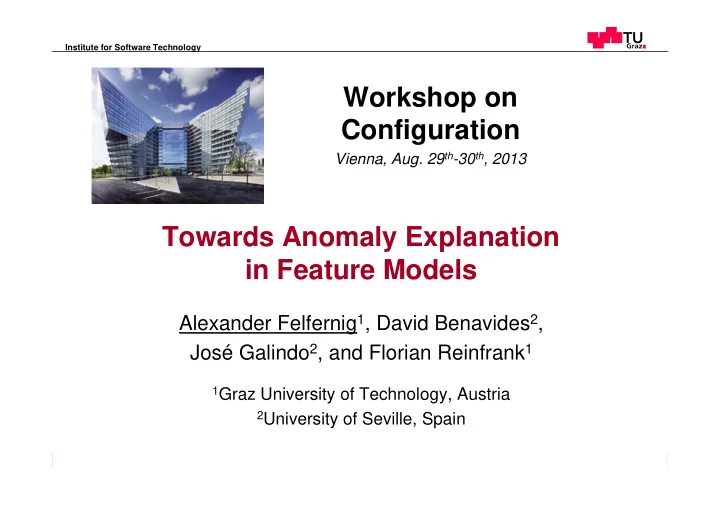

Institute for Software Technology Workshop on Configuration Vienna, Aug. 29 th -30 th , 2013 Towards Anomaly Explanation in Feature Models Alexander Felfernig 1 , David Benavides 2 , José Galindo 2 , and Florian Reinfrank 1 1 Graz University of Technology, Austria 2 University of Seville, Spain Alexander Felfernig 1
Institute for Software Technology Overview • Introduction Feature 1. Feature Models (FMs): Modeling Concepts Modeling 2. FMs: Configuration Task Definition 3. FMs: Analysis Operations • Testing & Debugging 4. Configuration Models: Testing & Debugging Configuration 5. FM Analysis Operations as Test Cases 6. FM Analysis Operations & Explanations • Ongoing & Future Work Alexander Felfernig 2
Institute for Software Technology Feature Models (FMs): Modeling Concepts „XOR“ „OR“ Alexander Felfernig 3
Institute for Software Technology FMs: Configuration Task Definition Alexander Felfernig 4
5 Configuration Task: Example Institute for Software Technology Alexander Felfernig
6 FMs: Analysis Operations Institute for Software Technology Alexander Felfernig
Institute for Software Technology Configuration Models: Testing & Debugging t j T: inconsistent(CF t j ) A. Felfernig, G. Friedrich, D. Jannach, and M. Stumptner, c1 Consistency-based Diagnosis of configuration knowledge bases, in Artificial Intelligence, 152(2), 2004, pp. 213–234. c2 t1 c1 c4 c3 t2 c1 c5 c4 t3 c3 c4 c5 tn Conflicts c3 c5 Test Cases (T) ck Diagnosis ( ) Constraints (CF) Explanation CF: consistent (CF - t j ) t j T Alexander Felfernig 7
Institute for Software Technology FM Analysis Operations as Test Cases Example analysis operation : Test Case : t j T „Dead feature“ f i F ? t j : f i = true inconsistent (CF {f i = true} {c 0 }) Explanation CF: consistent (CF - {f i = true}) Alexander Felfernig 8
Institute for Software Technology FM Analysis Operations & Explanations Alexander Felfernig 9
Institute for Software Technology Explanations: Used Algorithms • Preferred conflicts (minimal) U. Junker. QuickXplain: Preferred explanations and relaxations for over-constrained problems. AAAI’04, pp. 167–172, 2004. • HSDAG with test cases A. Felfernig, G. Friedrich, D. Jannach, and M. Stumptner, Consistency-based Diagnosis of configuration knowledge bases, in Artificial Intelligence, 152(2), 2004, pp. 213–234. • Preferred diagnoses (minimal): FastDiag A. Felfernig, M. Schubert, and C. Zehentner. An efficient diagnosis algorithm for inconsistent constraint sets. AIEDAM, 26(1):53–62, 2012. • Redundant constraints: FMCore Alexander Felfernig , D. Benavides, J. Galindo, F. Reinfrank. Towards Anomaly Explanation in Feature Models, Workshop on Configuration, pp. 117-124, Vienna, Austria, 2013. Alexander Felfernig 10
Institute for Software Technology Evaluation A. Felfernig, M. Schubert, and C. Zehentner. R. Reiter. A theory of An efficient diagnosis algorithm for diagnosis from first principles. inconsistent constraint sets. AIEDAM, Artificial Intelligence, 26(1):53–62, 2012. 32(1):57–95, 1987. Alexander Felfernig 11
Institute for Software Technology Ongoing & Future Work • Further evaluation of algorithms (ongoing work with University of Seville) • Additional analysis operations (e.g., taking into account multiplicity bounds) • Improved prediction of the sources of faulty behavior (e.g., exploitation of eye tracking „confusion patterns“) • Algorithms for intra-constraint redundancies Alexander Felfernig 12
Institute for Software Technology Conclusions • Approach to integrate contributions of “Feature Modeling” and “Configuration” communities • Diagnosis & redundancy detection as a basis for the explanation of “well-formedness” violations • Generation of test cases on the basis of feature model analysis operations • No additional management overheads for the generated test cases • Not a substitute for “conventional” KB testing! Alexander Felfernig 13
Institute for Software Technology Thank You! Alexander Felfernig 14
Recommend
More recommend